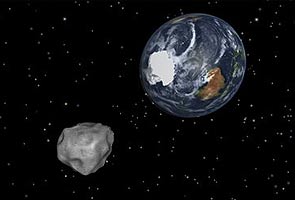
This image provided by NASA/JPL-Caltech
shows a simulation of asteroid 2012 DA14 (AP Photo)
The 150-feet (45-meter) wide asteroid -- dubbed 2012 DA 14 -- is expected to pass about 17,200 miles (27,000 kilometers) above the Earth at the time of closest approach, about 2:25 pm EST (1925 GMT), NASA said.
"This distance is well away from Earth and the swarm of low Earth-orbiting satellites, including the International Space Station," it said in a statement on its website.
The space agency insisted there was nothing to fear, saying: "NASA places a high priority on tracking asteroids and protecting our home planet from them."
The asteroid isn't nearly as large as the 10-kilometer (six-mile) wide object that took out the dinosaurs, but would be large enough to wipe out a large urban area if it were to strike the Earth's surface.
The asteroid will be visible in eastern Europe, Australia and Asia, according to astronomers. NASA said the flyby will provide a "unique opportunity for researchers to study a near-Earth object up close."
"What you would see through a small telescope would be something like a star, a small point of light... that moved against a background of stars," Tim Spahr, of the Harvard-Smithsonian's Minor Planet Center, said last week.
NASA's Jet Propulsion Laboratory in California planned a half-hour broadcast incorporating real-time animation to show the asteroid's location.
The Goldstone Solar System Radar, located in California's Mojave Desert, was meanwhile poised to take radar images of the asteroid over the coming days to determine its exact size and shape.
The 2012 DA 14 was discovered by chance by astronomers after passing nearby last February.
NASA estimates a smallish asteroid like 2012 DA 14 flies close to the Earth every 40 years on average but only hits our planet once every 1,200 years.
Astronomers have detected some 9,500 celestial bodies of various sizes that pass near Earth, but they estimate that's only a tenth of what's out there.
Even 2012 DA 14 was almost missed last year because of how quickly it passed through the observable sky, according to Jaime Nomen, one of the astronomers who spotted it from the La Sagra observatory in southern Spain.
NASA emphasized last week that it was keeping a careful watch on the skies, including with ever-improving telescopes that make nightly sweeps.
"We've found about 95 percent of those larger asteroids that come close to the Earth," Lindley Johnson, a top official in the space agency's Near-Earth Object Observations Program, said last week.
Smaller objects, like 2012 DA 14, are more numerous and harder to spot, he said, but NASA has found "lots" of them.
No comments:
Post a Comment